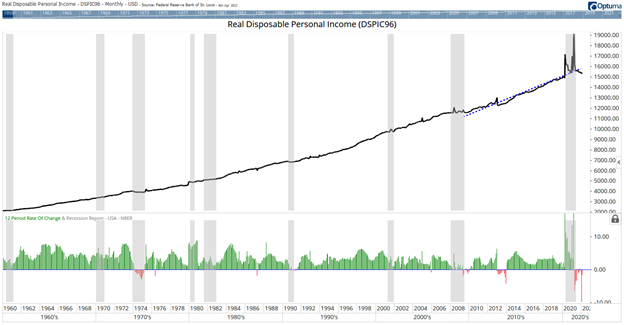Mean reversion is an important concept in economics. It explains the business cycle, and it reveals a problem in disposable income data.
In general terms, the business cycle consists of periods of expansion and contraction. As the economy expands, entrepreneurs create more businesses, and not all have sound business plans. The excesses of the expansion lead to a contraction in the economy as unsound businesses fail.
If the boom part of the cycle (expansion) goes too far, the bust (contraction) will be deeper. Mild contractions tend to follow mild expansions.
This pattern is in many economic data series. An example is real disposable income. Disposable income is the amount of money consumers have left after paying taxes. Real disposable income factors inflation into the calculation.
The chart below includes the one-year rate of change in real disposable income at the bottom. In the long run, this value generally ranged from 0% to 5%. Moves above 2% were always followed by moves back below 2% as income growth reverted to the mean.
Busts Follow Disposable Income Boom

Inflation Forces Hard Disposable Income Choices
Inflation has taken a dramatic toll on real disposable income, and the one-year rate of change is lower than it’s ever been. Of course, part of the decline is because the current year must compare to when stimulus payments boosted income.
The dashed line in the upper portion of the chart accounts for that. It’s the trend based on linear regression since the end of the last recession in 2009. Longer time frames show the same result. Therefore, real disposable income growth is below its long-term trend.
Families know this without using linear regression. Inflation is forcing many to make choices about spending.
If real income growth remains in negative territory, it will change how consumers think about the economy. Negative sentiment will drive decisions. That has historically been bearish for the stock market.
Michael Carr is the editor of True Options Masters, One Trade, Peak Velocity Trader and Precision Profits. He teaches technical analysis and quantitative technical analysis at the New York Institute of Finance. Follow him on Twitter @MichaelCarrGuru.




